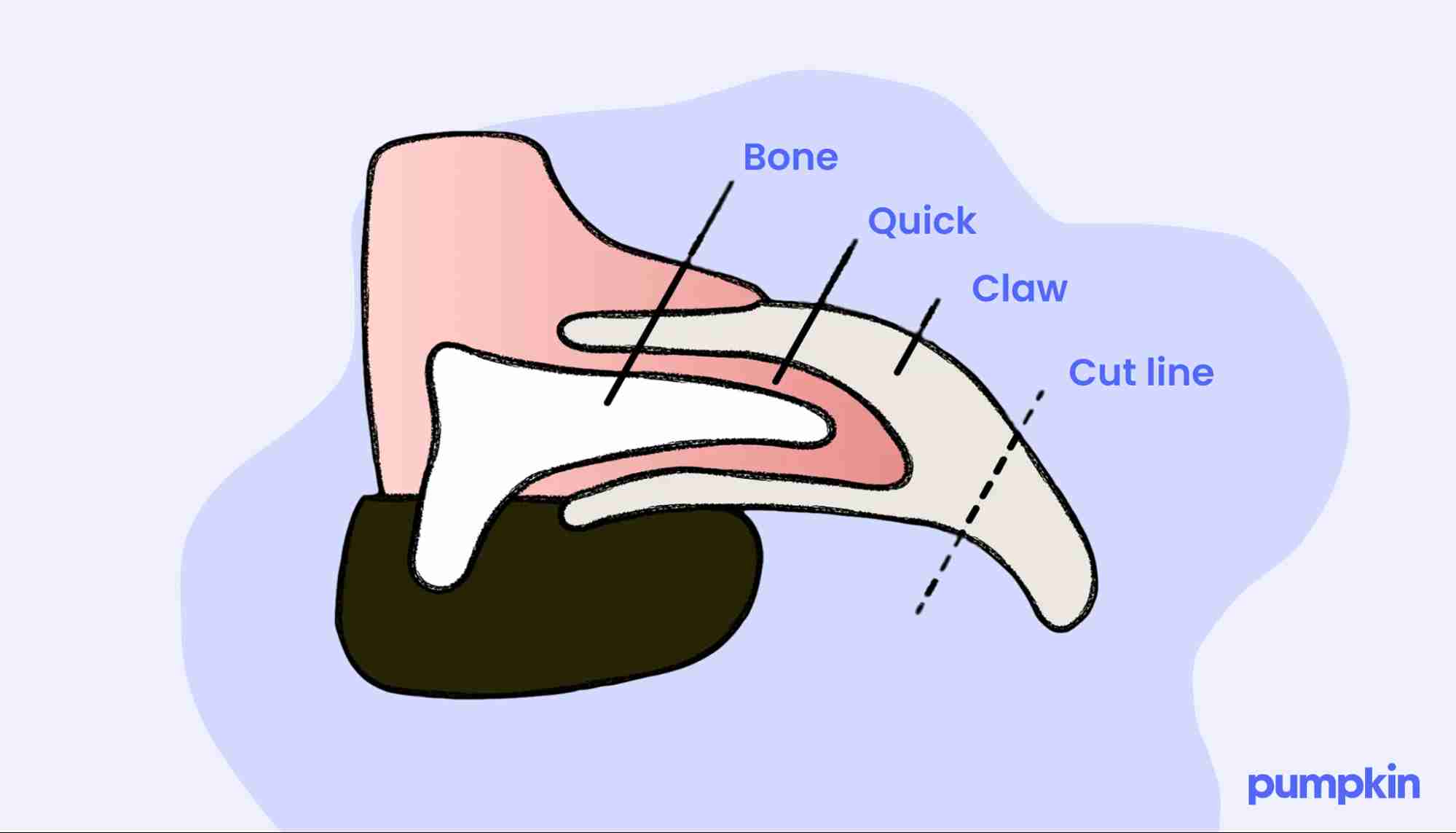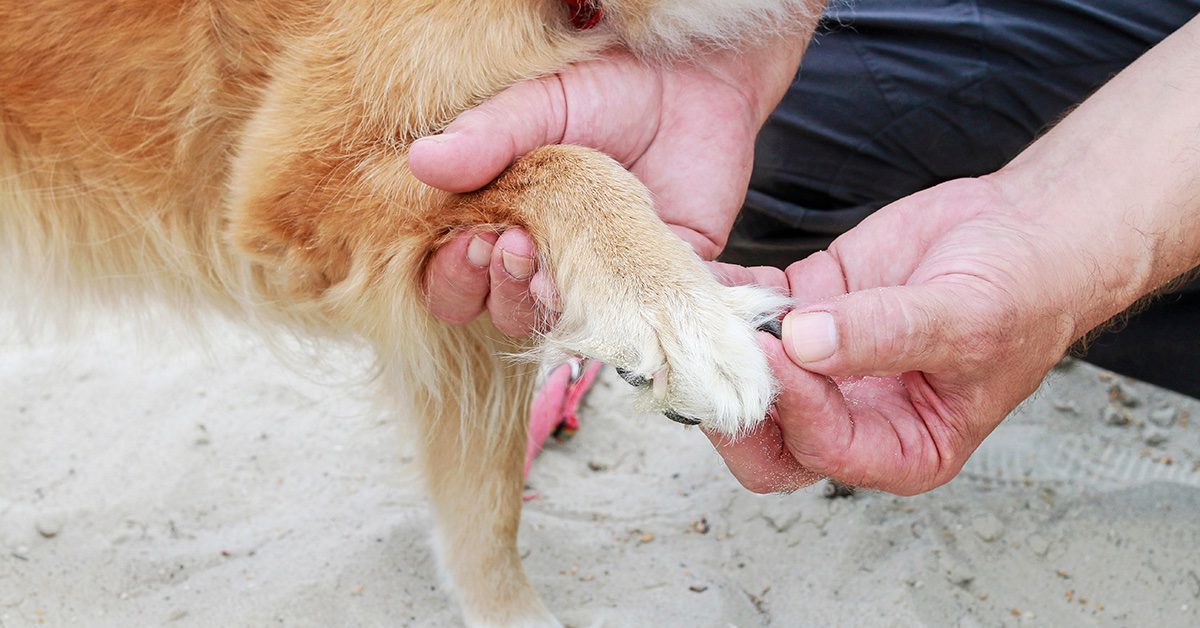Key Points
- If your dog broke a nail, your first job is to stop any bleeding, then carefully clean the affected area.
- Your dog’s nail may be broken if they’re guarding their paw, bleeding from their claw, yelping when you touch their claw, or constantly licking their nail.
- By regularly trimming your dog’s nails, you can reduce the chance of nails breaking or tearing in the future.
So your dog has a cracked, broken, or torn nail. Don’t panic — there’s plenty you can do to help your pup feel more comfortable, even at home.
While a broken nail might feel like an emergency for us humans (especially if you have a monthly manicure budget), broken nails are more complicated — and painful — for our dogs. Broken nails are one of the most common accidents for puppies and may require a visit to the veterinarian, depending on the severity of the break and whether the nail will stop bleeding on its own or not.
Not only is a broken nail very painful for dogs, but if left untreated, it can result in blood loss, nail bed infection, and other complications, so it’s best to consult your vet as soon as possible. Find out the symptoms, causes, and treatments for a pup with a broken nail so you’ll be prepared if your dog gets one.
Symptoms of a dog with a broken nail
A dog’s nail has two parts. The first part is a hard outer shell made of keratin and known as the claw. The second part is the nail bed, a collection of blood vessels and nerves that form “the quick.” The quick is living tissue attached to the bone with a large blood supply, and it’s extremely sensitive. Damage to the quick causes bleeding and pain, and it typically requires veterinary attention.

Here are a few common symptoms of a dog with a broken nail:
- They’re limping, unable to put pressure on their paw, or holding their paw off the ground
- They’re guarding their paw and don’t want you to inspect it
- They yelp or whine when you touch their paw
- They’re constantly licking their paw or nail area
- There’s visible blood on the nail or the area where your dog sleeps, such as their bedding
- You see a visibly torn nail
If you think your dog’s nail has been injured, the next step is to assess the severity. If it’s a minor break, you might be able to wait until the next day to see the vet. Some minor tears do not require treatment and heal on their own.
However, if the break or tear has reached the nail bed (the bloody part of the nail), you’ll want to seek veterinary care as soon as possible. How can you tell for sure? Well, let’s just say, there will be blood.
Common causes of broken nails in dogs
While it’s tough to completely avoid broken nails in dogs, it’s important to know why they occur in the first place. Here are a few common reasons.
Trimming nails too short: Be careful not to trim your dog’s nails too short, since doing so risks cutting into the quick. Before you reach for your own nail clippers, remember that it’s essential to use sharp nail trimmers made for dogs.
Snagging and tearing: One of the most common causes of a broken nail in dogs is the nail getting caught on carpet or other materials, such as tree roots or upholstery. That’s why it’s important to properly trim your dog’s nails, so they don’t grow long enough to get snagged.
Cracking on hard surfaces: A dog can damage their nails by jumping onto hard surfaces. This can cause the nail to break or bend.
Illness or cancer: Unfortunately, our pups aren’t immune to disease and sickness, and a broken or split nail could be a sign of a deeper health problem. For example, two potential signs of melanoma skin cancer are redness and weeping at the junction between the nail and the toe.
Pro Tip: One of the most common nail injuries happens to the dew claw, which is located higher up the inside of a dog’s foot. Many times this nail is removed when the dog is very young. If present, this claw is rarely trimmed, and because it’s higher up, it doesn’t have a chance to get worn down. As a result, it winds up growing longer than the other claws and has an increased chance of snagging and being torn or broken.
Treatment for dogs with broken nails
The treatment for a dog with a broken nail will depend on the severity of the break. If you want to err on the side of caution, it’s best to visit your vet. But if you’re tending to nail injuries at home, here are some tips:
- Stop the bleeding: If your dog will let you, apply moderate pressure to the affected area with a clean cloth, cotton ball, or gauze from a first aid kit.
- Keep the affected area clean: Once bleeding has stopped, run some warm water over the affected area and carefully dry it if your dog will let you.
- Schedule an appointment with your local veterinarian: Make an appointment as soon as possible to examine the claw and see if it needs further treatment or antibiotics.
If you’re unable to stop the bleeding, or if you can’t examine or touch the paw, take your dog to the veterinarian immediately. You can attempt to hold pressure on the paw with a towel, but remember the paw hurts. Scared and injured dogs may lash out.
Pro Tip: Styptic powder or a styptic pencil can help stop the bleeding by clotting the area. You can also use cornstarch, a silver nitrate stick, or cauterizing powder for the same result.
Recovery and care for dogs with broken nails
After treating the wound, keep the nail clean and dry. This means no licking allowed! Of course, preventing your dog from licking their injured paw is often easier said than done. So if they won’t leave it alone, you might need to resort to an Elizabethan collar, aka “the cone of shame.”

It’s also important to keep up with any medications your vet prescribed to your dog, whether pain medication or antibiotics. Your vet will likely want to see your dog for a follow-up visit to make sure they’re healing well.
How to help prevent your dog from breaking their nails
To avoid broken or torn nails in the future, be sure to trim your dog’s nails as regularly as possible, even if you have a puppy or are a first-time dog owner. Keeping them short will reduce the chances of a snagged and broken nail.
“If the nails are normal and there is no underlying medical issue, the best way to prevent broken and torn nails is to keep the dog’s nails short and well-trimmed,” says Dr. Jamie Whittenburg, veterinarian and director of Kingsgate Animal Hospital.
If you’re hesitant to use scissor-style clippers, you can try alternate methods of cutting your dog’s nails. Purchase electric nail files or guillotine-style clippers. And if you aren’t comfortable clipping your pup’s nails yourself — that’s perfectly fine! You can always take your dog to a groomer for help.
Pro Tip: Let your dog run or walk on coarse, abrasive surfaces such as asphalt or concrete paths. This can also help keep your dog’s nails at a short length, as the ground will wear away at the nails.
What to expect at the vet’s office
Your vet will likely remove the remaining broken or split nail, clean the wound, and apply an antiseptic ointment or powder to help prevent infection of the wound or bone. Next, they’ll wrap the paw to keep it protected throughout the healing process.
Depending on the severity of the wound, your vet may give your pup pain medication. In extreme cases, they may even sedate your dog before dressing the wound.
Accidents can pop up without warning, and a pet insurance plan can help your pup get high-quality care when they need it. Pumpkin Dog Insurance plans can help you cover the costs of eligible vet visits in the future, so you can give your dog the best care when the unexpected happens.
FAQs
- https://luckytail.com/blogs/pet/dog-toenail-anatomy#dog-nail-anatomy
- https://vcahospitals.com/know-your-pet/first-aid-for-broken-nails-in-dogs
- https://www.akc.org/expert-advice/health/what-are-dog-dewclaws/
- https://vcahospitals.com/know-your-pet/how-to-trim-a-dogs-nails
- https://www.zoetispetcare.com/blog/article/pet-first-aid
- https://www.akc.org/expert-advice/health/how-to-trim-dogs-nails-safely/
DISCLOSURE
Disclosure: This post contains affiliate links at no additional cost to you. We may earn commissions from Amazon or other vendors through these links. As an Amazon Associate, Pumpkin earns commissions from qualifying purchases.




